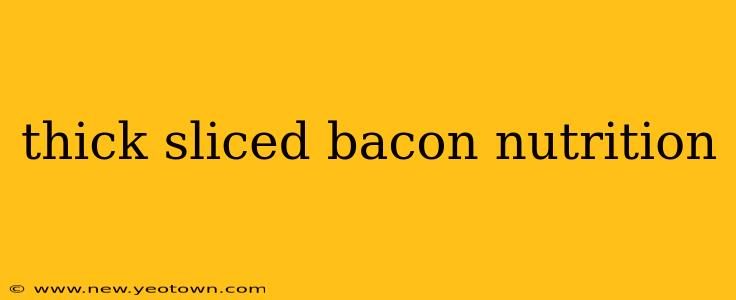Let's be honest, the aroma of thick-cut bacon sizzling in a pan is enough to make anyone's mouth water. But beyond the delicious smell and taste, what's the nutritional story behind this breakfast (or any-time-of-day) staple? We're diving deep into the nutritional profile of thick-cut bacon, addressing some common questions and concerns.
What are the nutritional benefits of thick-cut bacon?
This is a tricky question! While bacon isn't exactly a nutritional powerhouse in the same way that, say, spinach is, it does offer some nutritional value. A serving of thick-cut bacon does contain small amounts of protein and certain B vitamins, like niacin and thiamin, crucial for energy metabolism. However, it's important to remember that these benefits are significantly overshadowed by the downsides discussed later.
How many calories are in thick-cut bacon?
The calorie count in thick-cut bacon varies wildly depending on the brand, the thickness of the cut, and the cooking method. However, a typical 3-4 slice serving (around 50g) can range from 150-250 calories. Those seemingly small slices pack a caloric punch!
Is thick-cut bacon high in sodium?
Absolutely. Bacon is notoriously high in sodium, and thick-cut bacon is no exception. The high sodium content contributes to its savory flavor but can be a significant concern for individuals watching their sodium intake due to high blood pressure or other health conditions. Always check the nutrition label for the specific sodium content of your chosen brand.
What are the health risks associated with eating thick-cut bacon?
The high saturated fat and sodium content of thick-cut bacon are the primary health concerns. Saturated fat contributes to elevated cholesterol levels, increasing the risk of heart disease. The high sodium content, as mentioned, can negatively impact blood pressure. Furthermore, processed meats like bacon have been linked to an increased risk of certain cancers. Moderation is key!
How does thick-cut bacon compare to regular bacon nutritionally?
The main difference lies in the fat content and overall calorie count. Thick-cut bacon typically has a higher fat content per slice compared to regular bacon due to its increased thickness and higher fat-to-lean ratio. This translates to more calories and a richer, more intense flavor. However, the overall nutritional profile – high in sodium and saturated fat – remains largely similar regardless of the thickness.
How much thick-cut bacon should I eat per day?
There's no magic number, and it depends largely on your overall diet and health goals. If you are consuming thick-cut bacon, limiting yourself to a very small serving (1-2 slices) a few times a week is a reasonable approach for most people. Prioritize it as an occasional treat, not a daily staple.
Can I cook thick-cut bacon in a healthier way?
You can minimize some of the negative effects by opting for healthier cooking methods. Baking or air-frying bacon can reduce the amount of added fat compared to pan-frying. Even better, use a nonstick pan and drain off excess grease after cooking.
Conclusion: Enjoy in Moderation
Thick-cut bacon is undeniably delicious, but it's crucial to consume it in moderation. Be aware of the high saturated fat, sodium, and calorie content. Make informed choices, opt for healthier cooking methods, and enjoy it as part of a balanced diet. Remember, everything in moderation!

